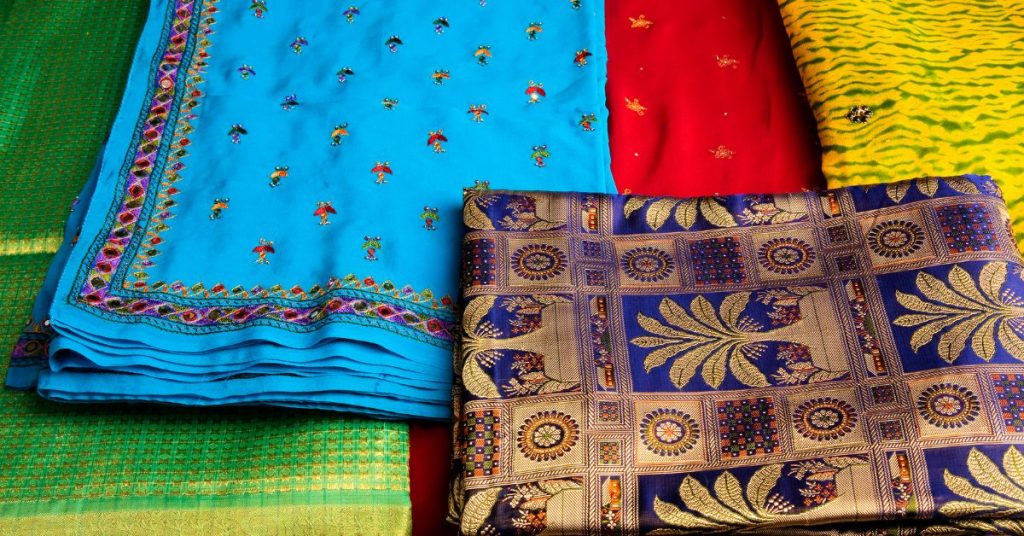For centuries, traditional Indian sarees have been a staple of the Indian fashion world. These pieces of clothing represent more than just fashion—they showcase culture and history in an elegant and beautiful way. Today, the saree industry is undergoing a renaissance of sorts. With growing interest in traditional clothing among millennials, designers are being pushed to create innovative and modern interpretations of classic sarees. In this article, we’ll take an exclusive sneak peek at what’s next for Indian sarees. From the materials used to new silhouettes and designs, read on to find out what’s in store for this timeless garment.

The Indian Saree: A Brief History
The saree is a traditional prominent Indian garment that has been around for centuries. Though its exact origins are unknown, the saree is thought to have first originated in the subcontinent of India. It is believed that the first sarees were made of simple cotton or silk fabrics and were draped around the body in a specific way. The saree eventually evolved into the more elaborate and ornate designs that we see today.
The saree is traditionally worn by Indian women on special occasions such as weddings and festivals. It is also commonly worn by Indian women in daily life. The saree can be made from a variety of different fabrics including cotton, silk, georgette, and chiffon. It is usually decorated with beautiful embroidery, beads, and sequins.
Over the years, the saree has become popular outside of India as well. In recent years, many Western celebrities have been seen wearing sarees on the red carpet and at other high-profile events. The saree is also becoming increasingly popular as a wedding dress choice for brides of all backgrounds.
As the popularity of the saree continues to grow, we can expect to see even more innovative and beautiful designs in the future.
The Different Types of Indian Sarees
Sarees are the traditional garment of choice for Indian women, and they come in a variety of different styles. The most common type of saree is the six-yard saree, which is made up of a long piece of fabric that is draped around the body. This type of saree is usually made from cotton or silk, and it can be decorated with a variety of different embroidery designs.
Another popular type of saree is the nine-yard saree, which is slightly longer than the six-yard saree. This type of saree is often made from cotton,silk and cotton silk fabrics, and it is usually worn during special occasions. Nine-yard sarees are also often decorated with elaborate embroidery designs, and they typically have a lot more fabric than six-yard sarees.
The third type of saree is the half-saree, which only covers half of the body. Half-sarees are typically worn by young girls or women who are not yet married, and they are usually made from lighter fabrics like cotton or chiffon. Half-sarees typically have much less fabric than either six-yard or nine-yard sarees, and they are not as commonly decorated with embroidery.
What’s Next for Indian Sarees?
As India continues to modernize, the saree is evolving with the times. Designers are experimenting with new silhouettes and materials, and the traditional dress is becoming more popular among younger women. Here’s a look at what’s next for Indian sarees:
Silk sarees are still the gold standard for special occasions, but cotton and other fabrics are gaining popularity for everyday wear. Designers are also playing with different draping styles like pre-draped saree, jacket style saree,cape and poncho style,gown and skirt style so we can expect to see more innovative ways of wearing a saree in the future.
Prints are getting bolder and brighter, as women embrace patterned sarees as a way to express their personal style. Floral prints are especially popular right now, but we’re also seeing geometric patterns and abstract designs.
Embellishments like zardozi,dabka, sequins, beads, and embroidery are being used to add extra visual interest and richness to sarees. We’re also seeing a lot of experimentation with different types of fabric, such as organzas,tissue, netting and lace.
While the classic six-yard saree will always have a place in Indian culture, we’re excited to see how this iconic garment continues to evolve in the years to come.
How to Wear an Indian Saree
When it comes to Indian sarees, there are a few different ways to wear them. The most popular way is to drape the saree around the waist and then over the shoulder. This gives the saree a more fitted look and helps to accentuate your curves.
Another way to wear an Indian saree is to wrap it around your head like a dupatta. This gives the saree a more traditional look and is perfect for special occasions.
Finally, you can also wear an Indian saree as a skirt by wrapping it around your waist and letting it flow down to your feet. This is a great option if you want to show off your legs or pair the saree with a crop top.
Shopping for an Indian Saree
When shopping for an Indian saree, it is important to keep in mind the occasion for which you are purchasing the saree. Indian sarees come in a wide variety of colors, fabrics, and styles, so it is important to select a saree that is appropriate for the event. If you are unsure of what type of saree to purchase, it is always best to ask the salesperson for help in selecting the right saree for you.
As discussed in this article the present era is witnessing old traditional styles and designs of royal sarees such as passionate patolas in pastel hues, organza tissue in rich embellishments and floral prints, alluring brocade and net sarees with delicate pearl and royal zardozi work.You can shop these exclusive sarees both online and offline at many fashion stores dealing with these prominent sarees, mentioning here one of the best traditional brand of exquisite sarees – Amrut fashion icon studio, premium fashion store for all traditional and contemporary styles of sarees for weddings and parties under one roof. When shopping from their website at www.amrut.co you can also avail discount on sarees from their exclusive collection.
Conclusion
The future of Indian sarees looks really promising with all the new and exciting trends that have emerged over the past few years. From haute couture to designer pieces, you can find something perfect for any occasion. With more innovative designs and fabrics being introduced in the market, there are plenty of options to choose from when it comes to deciding on your next purchase. Whether you’re looking for a unique conversation piece or something timelessly elegant, an exclusive sneak peak at what’s next for Indian sarees has just made choosing easier than ever before.
 World inside pictures Collect and share the best ideas that make our life easier
World inside pictures Collect and share the best ideas that make our life easier








